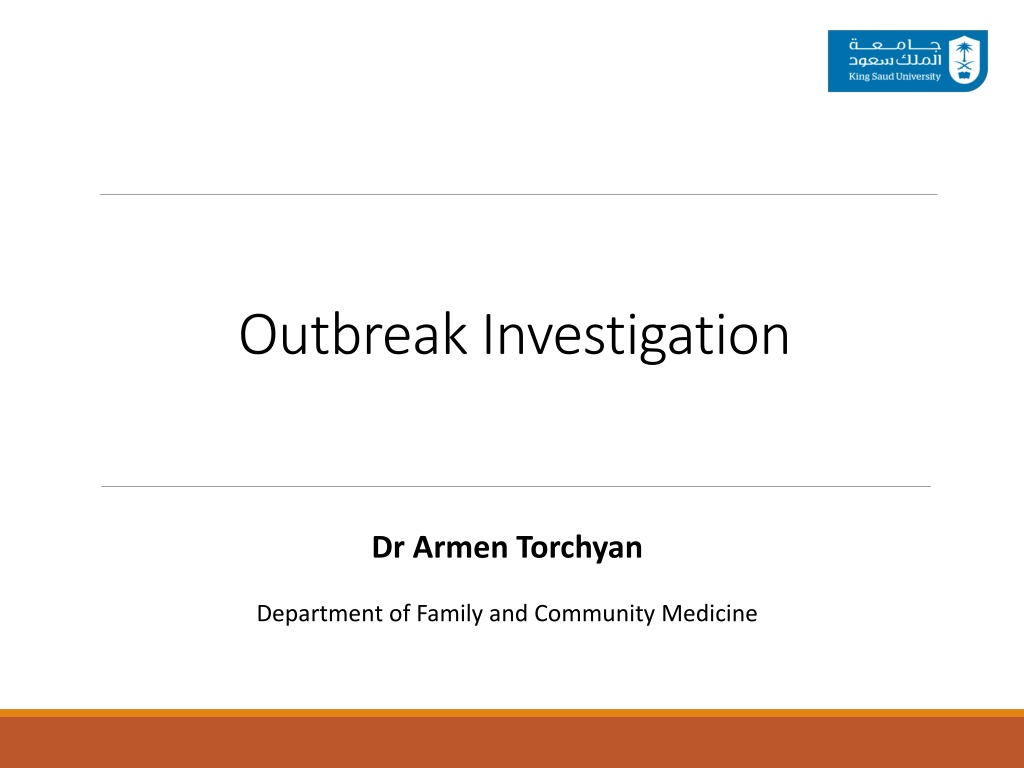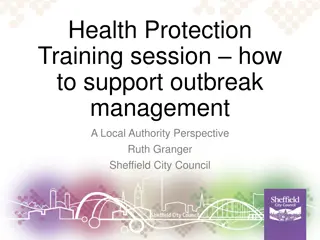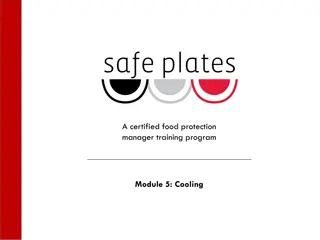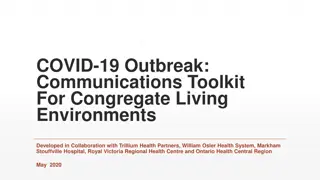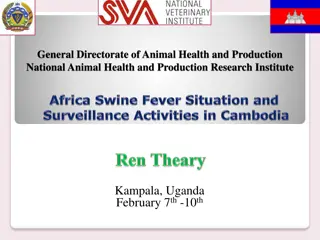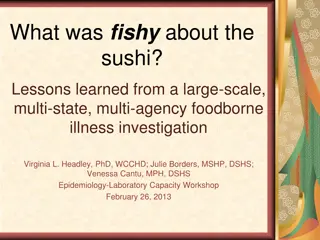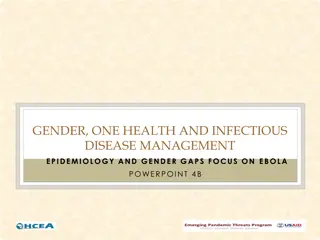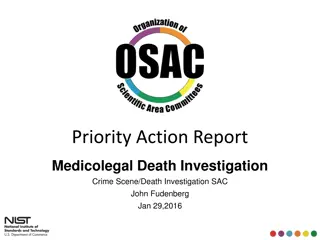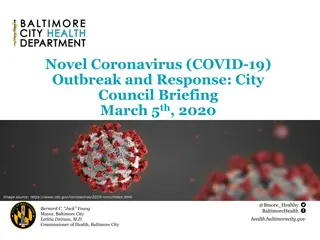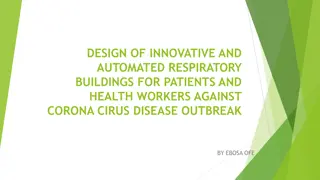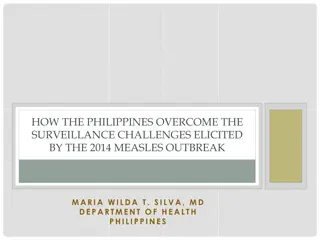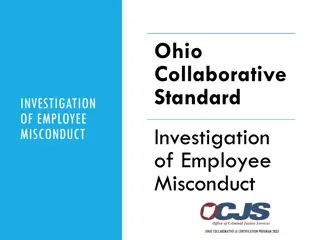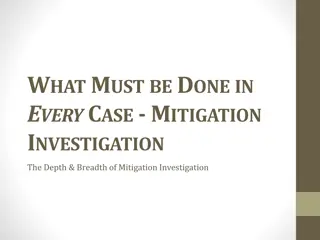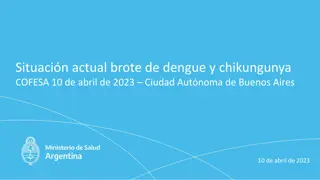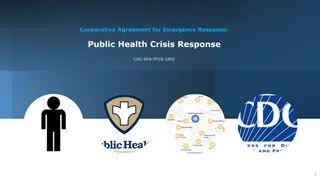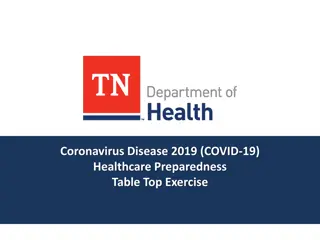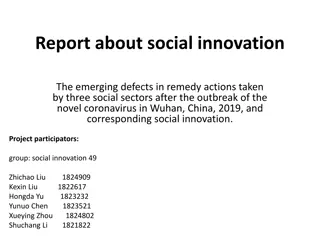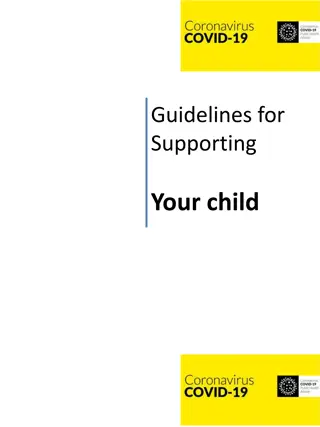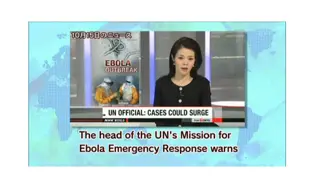Outbreak Investigation and Management in Public Health
Outbreak investigation is crucial in understanding, distinguishing, and managing disease outbreaks. This involves identifying the nature of outbreaks, studying key terms like endemic and epidemic, and examining outbreak settings such as food-borne and water-borne scenarios. By investigating outbreaks, public health officials can prevent future occurrences and safeguard community well-being.
Download Presentation

Please find below an Image/Link to download the presentation.
The content on the website is provided AS IS for your information and personal use only. It may not be sold, licensed, or shared on other websites without obtaining consent from the author. Download presentation by click this link. If you encounter any issues during the download, it is possible that the publisher has removed the file from their server.
E N D
Presentation Transcript
Outbreak Investigation Dr Armen Torchyan Department of Family and Community Medicine
Objectives Understand what constitutes to an outbreak Distinguish between endemic and epidemic Learn the importance of investigating an outbreak List the steps of an outbreak investigation Describe types of studies used to investigate an outbreak Read an epidemic curve and use it in estimating the incubation period Calculate the attack rate from outbreak investigation data 2
Key terms Sporadic: a disease that occurs infrequently and irregularly. Endemic: the habitual presence of a disease within a given geographic area. Hyperendemic: persistent, high levels of disease occurrence. Epidemic: the occurrence of more cases of disease than expected in a given area or among a specific group of people over a particular period of time. Usually, the cases are presumed to have a common cause or to be related to one another in some way Outbreak: epidemic limited to localized increase in the incidence of disease Cluster: aggregation of cases in a given area over a particular period without regard to whether the number of cases is more than expected Pandemic: An epidemic that has spread over several countries or continents, usually affecting a large number of people.
Outbreak settings Most outbreaks are caused by exposure to contaminated food, water, or direct contact with others Food borne outbreaks: most common Waterborne outbreaks: infection occurs by either ingesting contaminated water or swimming in contaminated water Community/institution acquired outbreaks: most widely varied Others Illness can be minor self-limited diseases, or major deadly diseases Successful investigation of an outbreak can lead to positive advances in future protection of public health 5
Food-borne Outbreaks The most common outbreak is in a food borne setting. A food-borne outbreak is generally considered to exist if there are more than two reports of a similar illness from the same food source, frequently in a restaurant or at a community dinner. A food-borne outbreak may have a widely varied number of cases, and has no seasonal distribution. While the food-borne outbreak is the most common, in only about 50% of the outbreaks is the food culprit identified, so a large number of these outbreaks go unsolved.
Water-borne Outbreaks In disease that occurs from a water-borne outbreak, infection occurs by either ingesting water contaminated by pathogens or by swimming in water contaminated by pathogens. Most often, these outbreaks are common source types. The numbers of cases in these outbreaks can be variable and often unknown. The most common agents responsible for water-borne outbreaks are norovirus, Shigella, Giardia, Crytosporidiosis, and E. coli.
Community/Institution Acquired The most widely varied of the outbreak settings Include most all types of infectious diseases, such as respiratory diseases and gastrointestinal diseases. Transmitted most often by person-to-person transmission in schools, hospitals, daycare, nursing homes, prisons, and high density living areas such as military barracks, hotels, and even airplanes. Some common agents that cause the diseases acquired in a community setting include norovirus, varicella, influenza, rhinovirus, parasites, and adenovirus.
Exercise 1. 22 cases of legionellosis occurred within 3 weeks among residents of a particular neighborhood (usually 0 or 1 per year) Epidemic disease 2. Average annual incidence was 364 cases of pulmonary tuberculosis per 100,000 population in one area, compared with national average of 134 cases per 100,000 population Hyperendemic 3. Over 20 million people worldwide died from influenza in 1918 1919 Pandemic 4. Single case of histoplasmosis was diagnosed in a community Sporadic 5. About 60 cases of gonorrhea are usually reported in this region per week, slightly less than the national average Endemic
Detecting outbreaks https://healthmap.org/en/ Regular, timely analysis of surveillance data Reports of cases of notifiable diseases Alert clinicians call the health department. Patients or community members can report to the health department
Epidemic Patterns Common-source oPoint - everyone becomes ill within one incubation period oContinuous - exposed over a period of days, weeks, or longer oIntermittent - intermittent nature of the exposure Propagated Mixed Other
Common-source All cases of the infectious disease are acquired from the same source in a limited period of time and in a limited geographical location. It is also characterized by very minimal (or zero) transmission from person to person. Generally, a common source outbreak has a smaller number of cases than a propagated outbreak and is often caused by contaminated food or water. A typical example of a common source epidemic is a food borne illness caused by exposure to one specific food or restaurant. Common source epidemics are usually characterized by a dramatic single peak of cases. Many common source outbreaks go unreported since they are generally small in numbers andoften don t come to the attention of public health authorities.
Common-source Point Focus on Field Epidemiology, Volume 1, Issue 5
Common-source Continuous Focus on Field Epidemiology, Volume 1, Issue 5
Common-source Intermittent Focus on Field Epidemiology, Volume 1, Issue 5
Propagated Characterized by an outbreak that continues over an extended period of time. This outbreak has individuals exposed to the original source, but then will also have secondary infections in individuals exposed to those initially ill people via person-to- person spread. The propagated epidemic usually lasts for a longer period of time and has various numbers of peaks of cases over time. The initial source often resolves, but the outbreak continues by affected persons infecting other persons. Propagated outbreaks often result in larger numbers of cases than common source outbreaks. Most outbreaks of respiratory diseases, such as influenza, are propagated outbreaks, as well as some food or water borne outbreaks such as those occurring from norovirus infections.
Propagated Focus on Field Epidemiology, Volume 1, Issue 5
Exercise 1. 21 cases of shigellosis among children and workers at a day care center over a period of 6 weeks, no external source identified incubation period for shigellosis is usually 1 3 days) Propagated 2. 36 cases of giardiasis over 6 weeks traced to occasional use of a supplementary reservoir (incubation period for giardiasis 3 25 days or more, usually 7 10 days) Intermittent or continuous common source 3. 43 cases of norovirus infection over 2 days traced to the ice machine on a cruise ship (incubation period for norovirus is usually 24 48 hours) Point source
Making Epidemic Curves 1. Plot the number of reported cases on the y-axis. 2. Plot the date/time of symptom onset on the x-axis. 3. Choose an appropriate time interval for the x-axis, or try several to see which best represents the data. 4. Include pre-outbreak time on the x-axis to show the baseline disease level and to show visually when the outbreak began. 5. Label the x and y-axes clearly. 6. Give the epi curve a descriptive, self-explanatory title. 7. Include more detailed information, such as cases by geographic location or by symptom, if helpful. 8. To be technically correct, make the bars touch each other (unless there are periods of time with no cases, in which case there will be space between the bars).
Steps in an Outbreak Investigation Each day, health departments learn about cases or outbreaks that require investigation. o Although the U.S. CDC receives over 1000 reported outbreaks per year, this is likely only the tip of the iceberg o Many times outbreaks are not seen in their entirety and never reported o 75 million food-borne illnesses in the U.S. each year are estimated to be part of an outbreak that is not reported Epidemiologists have an outbreak cookbook o The 10 steps of an outbreak investigation assist epidemiologists in investigating an outbreak o Allows investigators to have the best success in determining the cause of the outbreak and preventing future cases of the same disease 21
Steps in an Outbreak Investigation Steps organized into categories that: Identify that a problem exists Measure the problem Find the responsible agent Prevent it from occurring further Each step is dependent on the successful completion and information obtained in the previous step(s) 22
Steps in an Outbreak Investigation 1. Confirm the Diagnosis Identify that a problem exists 2. Confirm the Existence of an Outbreak/Epidemic 3. Define a Case and Count Cases Measure the problem 4. Orient Data in Terms of Person, Place and Time 5. Determine Who Is at Risk 6. Develop a Hypothesis and Test It Find the responsible agent 7. Determine Control Measures 8. Plan a More Systematic Study Prevent it from occurring further 9. Execute Disease Control and Prevention Measures Table 9-2 The Steps of an Outbreak Investigation 10. Prepare a Written Report 23
Step 1: Confirm the Diagnosis Symptoms need to be reviewed. Disease must be properly diagnosed: Re-look at records and visit existing cases Ensure suspected illness is properly diagnosed Confirm laboratory results/rule out errors Visit/assess patients (cases) Summarize clinical and laboratory findings 24
Step 2: Confirm the Existence of an Outbreak/Epidemic Very important to establish that the disease being seen in the community is in fact an outbreak - Investigations can be costly and time consuming - Normal rate of illness in the population must be known - Time is critical What is expected number of disease? Use Health Department Surveillance data Use hospital discharge records Use vital records Use registries May need to use neighboring rates Last resort: conduct a survey 25
Step 2: Confirm the Existence of an Outbreak/Epidemic Establishing existence of a disease uses concept of epidemic threshold Normal rates of disease over time used to determine range of normal high and low limits Normal high limit used to determine if there is an excess Any amount of disease over threshold is considered to be excess of normal 26
Step 3: Define a Case and Count Cases Case classification (definition) should include: Clinical symptoms ( 1 symptom can change accuracy) Laboratory verification Restrictions of person, place, and time Do not include the exposure or risk factor you are interested in evaluating Must classify if cases are confirmed, suspected, or probable Count cases: Important to find and count all cases that exist Cast a wide net Health clinics, hospitals Advertise Ask other cases 28
Meningococcal Disease Case Definition Clinical case definition An illness with sudden onset of fever (>38.5 C rectal or >38.0 C axillary) and one or more of the following: neck stiffness, altered consciousness, other meningeal sign or petechial or puerperal rash. Laboratory criteria for diagnosis Positive cerebrospinal fluid (CSF) antigen detection or positive culture. Case classification Suspected: A case that meets the clinical case definition. Probable: A suspected case as defined above and turbid CSF (with or without positive Gram stain) or ongoing epidemic and epidemiological link to a confirmed case. Confirmed: A suspected or probable case with laboratory confirmation. Source: Pan American Health Organization. Case Definitions Meningococcal Disease. Epidemiological Bulletin 2002; 22(4):14 5.
Line listing Focus on Field Epidemiology, Volume 1, Issue 4
Step 4: Orient Data in Terms of Person, Place, and Time Get to know your data Descriptive Epidemiology Person: age, race, gender, medical status, exposures Place: map cases (GIS) Map attack rates, not numerators Time: Epidemic curve Orienting groups of cases by time provides more information about the outbreak and possible cause Graphing number of cases over time provides an epidemic curve Earliest set of cases to appear on graph can identify date of first exposure Can help identify type of outbreak and secondary attack rate 31
Epidemic curve See Figure 9-2 34
Epidemic curve Figure 9-2 Example of an Epidemic Curve 35
Step 5: Determine Who is at Risk Necessary to gather information from subjects who are not cases Population at risk is important because: It will be the population used as controls Approach subjects for a study to test the hypothesis to find the cause of the outbreak It defines the population for whom prevention and control measures will be targeted 36
Step 5: Determine Who is at Risk Where did the cases come from Using definition of cases, identify population with the same criteria Geographic location Time period Population characteristic Look for any remaining cases in population at risk This population will also be the target of prevention and control measures Table 9-7 Step 5: Define and Investigate the Population at Risk 37
Step 6: Develop a Hypothesis and Test It Develop a hypothesis to confirm the cause of disease Include suspected etiologic agent Include mode of transmission Identifies expected exposures to transmit the disease Specifies population Test the hypothesis using a study design Case-control study if the population is not well defined and speed of investigation is important Table 9-8 Cohort study if the population is small and well defined Step 6: Develop a hypothesis and test it 39
Example of a Cohort Study A community in Massachusetts experienced an outbreak of Salmonellosis. Health officials noted that an unusually large number of cases had been reported during a span of several days. Descriptive epidemiology was conducted, and hypothesis-generating interviews indicated that all of the disease people had attended a parent-teacher luncheon at a local school. The descriptive epidemiology convincingly indicated that the outbreak originated at the luncheon, but which specific dish was responsible? The investigators needed to establish which dish was responsible in order to clearly establish the source and to ensure that appropriate control measures were undertaken. 40
Risk Ratio = (Incidence in the exposed group) / (Incidence in the unexposed group) Risk Ratio = (Incidence in the exposed group) / (Incidence in the unexposed group)
Example of a Case-Control Study Within a short period of time 20 cases of hepatitis A were identified in the Marshfield area. The epidemic curve suggested a point source epidemic, and the spot map showed the cases to be spread across the entire South Shore of Massachusetts. Hypothesis-generating interviews resulted in five food establishments that were candidate sources. The investigators identified as many cases as possible, and they selected a sample of non-diseased people as a comparison group (the controls). The "controls" were were matched to the cases with respect to age, gender, and neighborhood of residence. Investigators then ascertained the prior exposures of Figure 9-3 Food-Specific 2 X 2 Table for Fictitious Illness and Food subjects in each group, focusing on food establishments and other possibly relevant exposures they had had during the past two months. 43
Odds Ratio = (10/19) / (9/19) = 1.1 Odds Ratio = (18/7) / (1/29) = 75
Exercise You are called to help investigate a cluster of 17 persons who developed brain cancer in an area over the past couple of years. Most, perhaps all, used cell phones. Which study design would you choose to investigate a possible association between cell phone use and brain cancer? A case-control study is the design of choice
Step 7: Determine Control Measures Important to control current outbreak and prevent future outbreaks Control measures completely dependent on the identified source of the outbreak May include treating carriers of infection and vaccinating population at risk May include comprehensive training programs 46
Step 7: Determine Control Measures Destroy implicated food Close water source or beaches Treat carriers Vaccinate susceptible population Training Etc. Table 9-9 Step 7: Determine Control Measures 47
Step 8: Plan a More Systematic Study It may be necessary to continue to study the outbreak with a more comprehensive design Initial study may be inconclusive Reconsider hypothesis Revisit patients Expand exposures Utilize additional lab specimens Additional or more refined control group Table 9-10 Utilize a more comprehensive design Step 8: Perform a More Systematic Study Perform research to expand knowledge 49
Steps 9: Execute Disease Control and Prevention Measures As investigation wraps up, it is important to use all information available to prevent the spread or resurgence of outbreak Activities include: Implement the necessary control and prevention measures Treat carriers Vaccinate susceptible population Etc. Surveillance for future disease occurrence Regular communication with affected population and health care facilities 50
